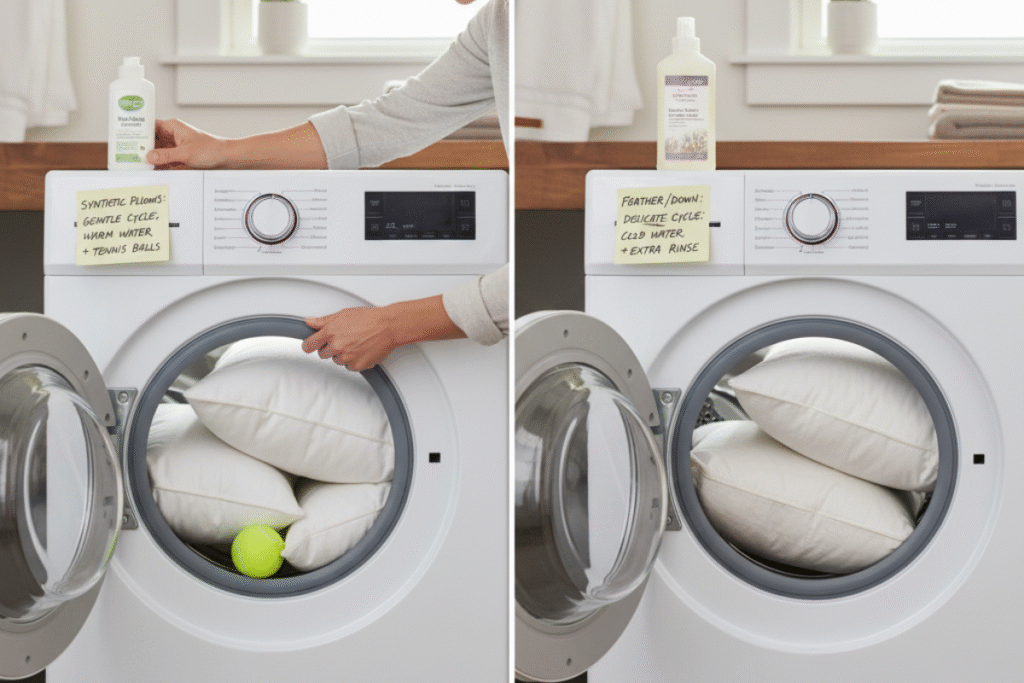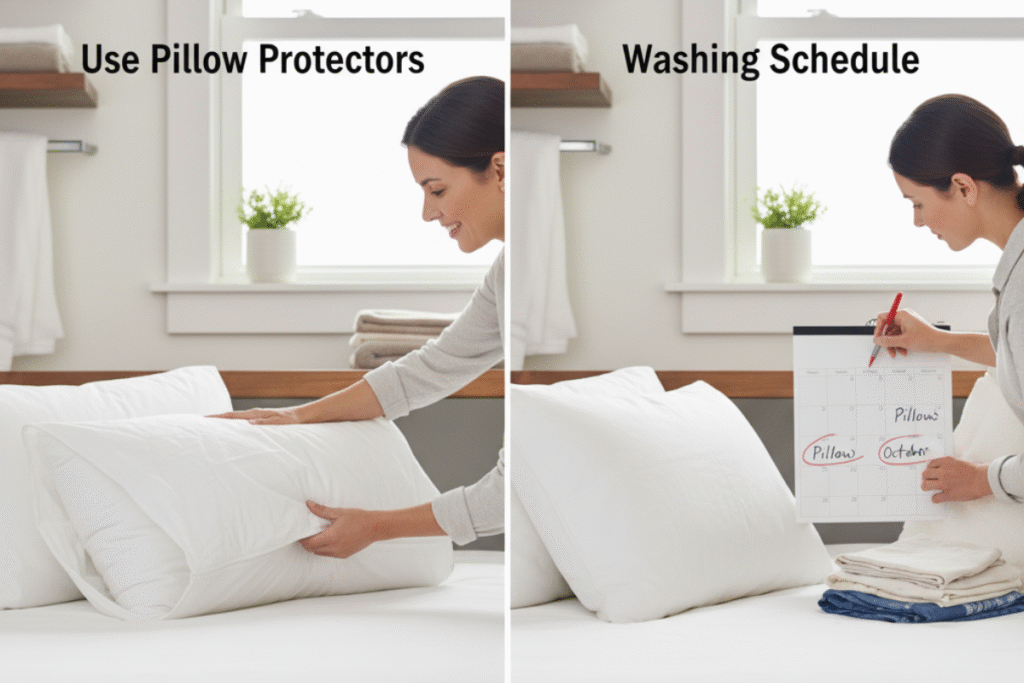Learn how to wash pillows in a washing machine safely and effectively. Discover the best settings, detergents, and drying methods for synthetic, down, and memory foam pillows to keep them clean, fluffy, and long-lasting
Wash pillows in a washing machine is one of the easiest ways to keep them fresh, hygienic, and comfortable. Most pillows—especially synthetic and down-filled—can be safely machine-washed if you use the right cycle, a gentle detergent, and cool or warm water. Knowing the proper method helps you avoid shrinking, clumping, or damaging the filling.
Not all pillows are created equal, though. Foam pillows typically require hand washing, while down and fiberfill options are generally safe for machine washing. That’s why the first step is understanding what type of pillow you’re dealing with.
Done correctly, washing pillows doesn’t just keep them clean—it also extends their lifespan, prevents odors, and makes bedtime a lot more pleasant.
Preparation Before Washing
Getting pillows ready before tossing them in the washer makes a big difference. A little prep keeps the pillow’s shape intact and protects your washing machine.
Check the Care Label
Every pillow comes with a tag that serves as its instruction manual. It will inform you whether it can be washed in the washer, what water temperature is best, and whether a gentle or normal cycle is safest.
- Synthetic and down pillows: usually washer-friendly.
- Memory foam or latex: typically spot clean or hand wash only.
Ignoring the label risks ruining the pillow—think lumps, shrinking, or split seams.
Remove Covers and Pillowcases
Always strip off removable pillowcases or protectors before washing. Wash them separately to avoid uneven cleaning or color transfer.
If there are stains on the cover, pre-treat them with a mild stain remover. And don’t forget to remove any accessories, such as buttons or clips—they can damage both the pillow and the machine.
Inspect for Damage
Check for weak seams, small tears, or holes. Even minor damage can worsen during a wash cycle, allowing the filling to leak out. If you encounter any issues, repair them first or opt for spot cleaning instead.
Choosing the Right Washing Machine Settings
Selecting the proper settings is crucial to cleaning pillows without damaging them.
Water Temperature
- Warm water: best for removing body oils and dirt without harming the filling.
- Cold water: safer for delicate fabrics and reduces shrinking.
- Avoid using hot water, as it can damage fibers and cause clumping.
Always double-check the care label before making a decision.
Cycle Selection
Use the gentle or delicate cycle. It reduces agitation, preventing the stuffing from bunching up or tearing the seams.
Some machines also have a “bedding” or “bulky items” cycle that works well for pillows. Skip high-speed spins, which can cause the pillow to lose its shape.
Load Size
Wash two pillows at a time to balance the drum. If you only have one pillow to wash, throw in a few towels to even things out.
For detergent, less is more—1–2 teaspoons of low-sudsing detergent is plenty. Too much soap makes pillows stiff and more difficult to rinse clean.
Best Detergents and Products for Pillows
The products you choose matter just as much as the settings you select.
Mild Detergent
Stick with a gentle, low-sudsing detergent. Harsh cleaners can break down fabric and filling over time. Liquids usually dissolve and rinse out better than powders.
Avoid bleach or strong fragrances, as they can weaken fibers or irritate sensitive skin.
Skip the Fabric Softener
Fabric softener might sound like a good idea, but it actually coats fibers, traps moisture, and can cause clumping—especially in foam or down pillows.
Instead, run an extra rinse cycle to ensure all detergent is removed.
Proper Pillow Placement in the Washer
How you load the machine is just as important as what settings you use.
Balance the Load
Always wash two pillows together. It keeps the washer from wobbling during the spin cycle and helps it clean evenly.
If washing only one, add a couple of towels or similar-sized items for balance. Place pillows loosely so water and detergent circulate properly.
Don’t Mix Pillow Types
Wash down pillows with down, and synthetic pillows with synthetic. Different fillings require different cycles, and mixing them often yields uneven results.
Foam pillows? Keep them out of the washer altogether—they break apart under agitation.
Washing Different Types of Pillows

Each pillow type has its own best washing method:
Synthetic Pillows
- Machine wash two items at a time in a gentle cycle using cool or warm water.
- Use 1–2 teaspoons of mild detergent.
- Run an extra rinse to remove residue.
- Tumble dry low with a couple of clean tennis balls to restore fluff.
Feather or Down Pillows
- Wash on delicate with cold water.
- Use a detergent formulated for down or wool.
- Avoid bleach or softeners.
- Dry on low heat with dryer balls to prevent clumps. Expect an extended drying time of several hours.
Memory Foam Pillows
- Do not machine wash.
- Spot clean with a mild detergent and water mix.
- To freshen, sprinkle baking soda, let sit, then vacuum.
- Always air dry completely before use.
Rinsing and Spinning Techniques
Extra Rinses
Soap residue can make pillows stiff and irritating to the skin. Running one or two additional rinse cycles ensures every bit of detergent is gone.
Spin Settings
A spin speed of around 800 rpm removes enough water without stressing seams. For delicate or down pillows, opt for a gentler spin to prevent clumping.
Drying Pillows After Washing
Drying thoroughly is just as critical as washing. Damp pillows quickly develop mold or have a musty smell.
Tumble Drying
- Use low heat or air-dry settings. High heat damages fibers.
- Add towels to absorb moisture and balance the load.
- Pause occasionally to fluff by hand.
- Expect 1–2 dryer cycles for complete drying.
Air Drying
Best for foam or delicate pillows. Lay flat in a ventilated area, flipping and fluffing every few hours. A fan speeds things up. Avoid prolonged exposure to direct sunlight, as it can cause fabrics to fade and lose their color.
Dryer Balls
Toss in a couple of wool or rubber dryer balls to keep them evenly distributed. They also reduce drying time and maintain the fluffiness of pillows.
Maintaining Pillow Cleanliness

Use Pillow Protectors
These add a washable layer that blocks sweat, oils, and dust mites. They reduce the frequency at which pillows need to be washed and are especially helpful for allergy sufferers.
Follow a Regular Washing Schedule
Wash pillows about every 3–4 months. If you use protectors, twice a year may be enough.
Too much washing can shorten the life of a pillow, but too little allows allergens and bacteria to build up. Stick to the balance recommended for your pillow type.
See This Also,How to Clean a Washing Machine Drum Naturally
Common Mistakes to Avoid
- Overloading the washer prevents the washer from performing its proper cleaning and rinsing functions.
- Skipping extra rinses: leaves soap trapped inside.
- Using hot water can damage delicate fillings.
- Too much detergent: makes pillows stiff and sticky.
- Failing to dry thoroughly can lead to the growth of mildew and unpleasant odors.
- Washing just one pillow: unbalances the machine.
- Machine-washing foam pillows can cause permanent damage.




